As I was preparing for West Medford Open Studios, I was going through my hives. Two of them – incidentally the ones in West Medford – introduced a unique challenge.
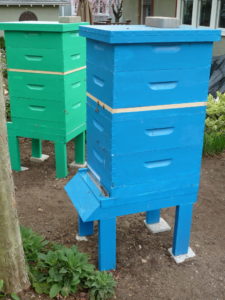
Week of May 2
The first week of May was quite horrendous. It was cold, it was foggy, it was rainy. I didn’t like it, and probably the bees didn’t either. The younger bees in the hive typically hold the in-hive positions: working around the clock to clean the hive, build comb, attend to brood, but as they get older they switch to foraging jobs, seeking nectar and pollen, coming back to the hive every night.
Bees use the Sun to navigate, that’s one of the reasons they don’t fly at night. Combined with the rain, they stay indoors during foggy weather.
Have you ever experienced “cabin-fever”? Imagine what cabin fever is like when you spend your days with your mom and your 40,000 siblings, in a dark two-square-foot box. I have not yet put honey supers on the hives, some of them were being fed. Since they were fed, I was not concerned they might run out of food during the foul weather, but I expected the overcrowding to affect some of the hives.
Hive Inspections
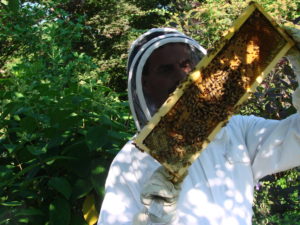
On Friday, May 6, I went to inspect my two Medford hives. Things did not look good, in quite opposite manners. I have two hives in my Medford beehive (where Open Studios took place), one painted green and one painted blue (hereafter: the green hive and the blue hive).
The Green Hive
Every hive is made of many, many workers, small number of drones (male bees), and usually one queen. The green hive had the workers, I didn’t see any drones (which is not an issue), but there was no queen to be found. There’s no guarantee a beekeeper would sight the queen in every inspection, but her presence can usually be detected through the presence of eggs. The green hive had no eggs (which take three days to hatch), no larvae (worker bees remain in the larva stage for six days), but it did have lots of sealed pupae brood (the last stage in the bees’ development, lasting 12 days for workers). That likely means that the queen was last alive 9-12 days previously.
There were no queen cells present (queen cells would indicate the hive is making a new queen). The hive was in trouble. Left alone it would perish. My initial thought was to bring the green hive some eggs from the neighboring blue hive, allowing them to raise a new queen. I left the green hive open, and turned to…
The Blue Hive
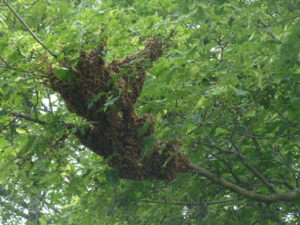
Opening the blue hive, I sensed a hive that is on the edge of swarming. That is a typical result of such congested conditions, as swarming is the process natural colonies use when they run out of space or conditions are good enough to justify splitting the hive in two, sending half the bees and the queen to find a new home. Beekeepers don’t like swarming, and it might be frowned upon by the neighbors. I needed to stop it, which is difficult, when the bees put themselves in the mindset for swarming, only decisive, clear action can redirect them to a different route.
The signs of swarming were clear: the hive was congested with bees, there were many, many drones and drone comb, but most telling of all, there were many queen cells present. 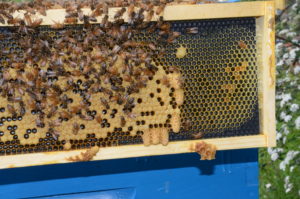
I found the queen. You see, once the new queen cells are ripe, the colony swarms with many of the bees leaving with the old queen. If I remove the old queen, she can’t leave the hive, and no swarming possible. I took her and put her in the observation hive.
The blue hive’s problem was now solved. They were not going to swarm, since they are now queenless. They’re going to right themselves, since they were in the process of making a new queen. I removed total of seven frames, to solve the congestion issue, and put honey supers on top of the hive, which will solve it even further. There was no need for a queen excluder – which prevents queen from laying eggs in the honey frames – as the blue hive did not have a laying queen at the moment. I also had my observation hive to show-and-tell, with a laying, marked and healthy queen. The green hive was still queenless, but they had some reinforcement.
Helping the Green Hive
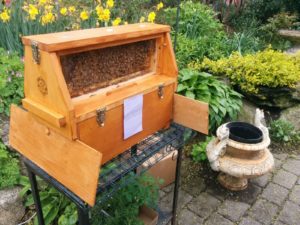
Open Studios went great. Many people came, saw the queen, heard lots about bees, it was fun. Now it was time to resume my efforts solving the green hive’s issue. I also had the bees in my observation hive that needed to be put someplace.
I opened the green hive, located and removed five frames that hardly had any bees in them. I concentrated five other frames with not many bees in a separate box, and added the five frames from the observation hive to it. So now, out of the three boxes of the green hive, one now holds the observation hive’s bees that come out of the blue hive. The green hive’s bees are not familiar with them, they’re probably not best friends. If just mixed together, they might fight it out, and the queen (imported from the blue hive) might pay the ultimate price, as the green hive’s bees would reject her.
That is why I have put all the other green hive’s bees in separate two boxes, away from their future hive-mates who I brought from the blue hive (in the way of the observation hive). I stacked them all together, but between them I place a newspaper. That was not to allow them some light reading material, but to keep them separate, allow them to gradually eat at the paper while their pheromones and smell mix in, with gradually increasing paths between the two hive parts. That is a method for merging two hives together, appropriately named “the newspaper method.” For good measure, I place honey supers on top of the hive. Within a day or two they’ll start to mingle together, within a week I expect them to become one big happy combined family. Hopefully, problem here averted as well.
So, to summarize:
- Swarming problem in the blue hive solved by removing the old queen and some bees (total of seven frames removed out of 30).
- Observation hive temporarily created for a weekend show-and-tell.
- Queenless green hive saved by introducing the old blue-hive queen using the newspaper method.
- Two healthy hives and one very happy beekeeper.
